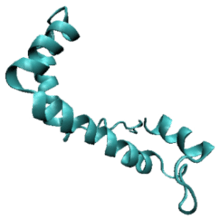Vanabins
Vanabins (also known as vanadium-associated proteins or vanadium chromagen) are a specific group of vanadium-binding metalloproteins. Vanabins are found almost exclusively in the blood cells, or vanadocytes of some ascidians and tunicates (sea squirts). The vanabins extracted from tunicate vanadocytes are often called hemovanadins. These organisms are able to concentrate vanadium to a level more than, and sometimes much more than, 100 times higher than in the surrounding seawater. Vanabin proteins seem to be involved in collecting and accumulating this metal ion. At present there is no conclusive understanding of why these organisms collect vanadium.

German chemist Martin Henze discovered vanadium in ascidiaceans in 1911.[1][2][3]
Theories
Vanabins as oxygen carriers
Because of the high concentration of vanadium in the blood, it has been assumed that vanabins are used for oxygen transport like iron-based hemoglobin or copper-based hemocyanin. Unfortunately no scientific evidence can be found to back this hypothesis.
The highest concentration of vanadium found so far, 350 mM, was found in the blood cells of Ascidia gemmata belonging to the suborder Phlebobranchia. This concentration is 10,000,000 times higher than that in seawater.[4]
Vanabins accumulate vanadium in the blood cells and produce V(III) species and vandanyl ions (V(IV)) from orthovanadate ions (V(V)), with the use of NADPH as a reducing agent. Vanabins also transport the reduced vanadium species into the vacuoles of vanadocytes (vanadium-containing blood cells). The vacuoles are kept at a very acidic pH of 1.9, made possible by pumping hydrogen ions into the vacuoles by use of energy intensive H+-ATPase. All the use of NADPH and ATP to collect and maintain the vanadium is extremely energy intensive, unusual for oxygen transporting proteins.
Other oxygen transporting proteins have a very low dissociation constant with their metal prosthetic group and bind these groups tightly. Vanabins on the other hand have a moderate dissociation constant and do not tightly bind vanadium. Most importantly, because of this moderate dissociation constant, vanadium is usually found free-floating and separated from any proteins inside the vacuoles. This is completely different from other oxygen transporting proteins.
Vanabins not oxygen carriers
The most convincing evidence against vanadium in use for oxygen transport is that many ascidians and tunicates also have hemocyanin in their blood that could be assumed to handle all oxygen transport.
The use of vanabins and vanadium for oxygen transport in ascidians and tunicates is doubtful. Another hypothesized reason for these organisms collecting vanadium is to make themselves toxic to predators, parasites and microorganisms.
Technological use of vanabins
The world oceans carry diluted concentrations of rare minerals. Total amount of gold, silver, manganese and platinum (among others) in all the world's oceans rivals that of terrestrial mines, yet because of the low concentration of these minerals in sea water, extraction has been considered impractical. Understanding the mechanisms behind how some organisms concentrate rare minerals (such as siderophores) from sea water could make it biotechnologically possible to grow and farm organisms to filter sea water and extract these minerals, similar to bioleaching.
References
- Henze M (1911). "Untersuchungen über das Blut der Ascidien. 1. Mitteilung. Die Vanadiumverbindung der Blutkörperchen" [Studies on the blood of sea squirts. I. Communication. The vanadium compound of the blood cells]. Biological Chemistry (in German). 72 (5–6): 494–501. doi:10.1515/bchm2.1911.72.5-6.494.
- Michibata H, Uyama T, Ueki T, Kanamori K (2002). Vanadocytes, cells hold the key to resolving the highly selective accumulation and reduction of vanadium in ascidians. Microscopy Research and Technique. Volume 56 Issue 6, Pages 421 - 434
- Henze, M. (1911). "Untersuchungen über das Blut der Ascidien. I. Mitteilung. Die Vanadiumverbindung der Blutkörperchen". Hoppe-Seyler's Zeitschrift für physiologische Chemie. 72 (5–6): 494–501. doi:10.1515/bchm2.1911.72.5-6.494.
- Tatsuya Ueki; Nobuo Yamaguchi & Hitoshi Michibata (2003). "Chloride channel in vanadocytes of a vanadium-rich ascidian Ascidia sydneiensis samea" (PDF). Comparative Biochemistry and Physiology. 136 (1): 91–98. doi:10.1016/s1096-4959(03)00175-1. PMID 12941642. Archived from the original (PDF) on 6 June 2014. Retrieved 13 August 2013.